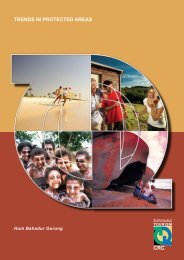icolls - Sustainable Tourism CRC
icolls - Sustainable Tourism CRC
icolls - Sustainable Tourism CRC
You also want an ePaper? Increase the reach of your titles
YUMPU automatically turns print PDFs into web optimized ePapers that Google loves.
ECOLOGY, THREATS AND MANAGEMENT OPTIONS FOR SMALL ESTUARIES AND ICOLLS<br />
SUMMARY<br />
Intermittently closed and open lakes and lagoons (ICOLLs) constitute over 60% of coastal waterways in southeastern<br />
Australia yet, in comparison with large estuaries, relatively little is known of the ecology of these<br />
intermittently open systems and their responses to perturbations. The importance of these unusual aquatic<br />
systems for recreation and tourism is widely recognised so it is timely that we investigate ICOLL ecology in<br />
conjunction with tourist use patterns to ensure that these systems are managed sustainably.<br />
ICOLLs play an important role in maintaining key coastal processes in south-eastern Australia, including<br />
provision of habitat for endangered species, nursery areas for commercially and recreationally valuable fish<br />
species, and important sinks for nutrients derived from industry and agriculture (Pollard 1994a; Roy, Williams,<br />
Jones, Yassini, Gibbs, Coates, West, Scanes, Hudson & Nichol 2001). In New South Wales, the Healthy Rivers<br />
Commission has suggested that many of the State’s ICOLLs are degraded beyond feasible ecological restoration,<br />
and therefore it is increasingly important to manage the less critically impaired systems in a manner that will<br />
ensure continued and/or enhanced beneficial uses, such as fisheries production, whilst not compromising<br />
important conservation and ecosystem health requirements.<br />
Current evidence suggests that pollution, habitat destruction and hydrologic changes threaten a considerable<br />
number of ICOLLs in northern New South Wales (Roy et al. 2001). Given that these changes have the potential<br />
to adversely affect coastal fisheries and the sustainability of coastal environments (Blaber, Cyrus, Albaret,<br />
Ching, Day, Elliott. Fonseca, Hoss Orensanz, Potter & Silvert 2000) there is a strong impetus for research<br />
investigating the key processes that maintain ecological structure and function in ICOLLs. Significantly, current<br />
coastal developments threaten the sustainable use of ICOLLs as important sites for tourism and recreation.<br />
Objectives of Study<br />
In this study we aimed to examine the ecological implications of coastal development, management strategies<br />
and visitor use of ICOLLs. Given the paucity of information on these systems in the scientific literature, we<br />
undertook basic ecological surveys in a series of ICOLLs in northern New South Wales in order to gather<br />
information that would underpin the development of conceptual models of the ecological structure and function<br />
of ICOLL ecosystems. Specifically, we aimed to assess the ecological consequences of the following<br />
perturbations on ICOLL ecology:<br />
• Artificial manipulation of opening regimes;<br />
• Excessive nutrient inputs from urban (sewage), agricultural and industrial sources; and<br />
• Removal of fish, molluscs and crustaceans as part of a recreational fishing resource.<br />
On the basis of our ecological surveys we developed a suite of conceptual models that related ecosystem<br />
structure and function to a series of anthropogenic perturbations. In addition to investigating the ecological<br />
resilience and resistance of ICOLLs to perturbations, we also sought to increase the national and international<br />
profile of this important subset of estuaries. We did this by running an ICOLL special session at an international<br />
conference in Ballina, New South Wales (20-25 June 2004). This conference had as its theme “Estuaries and<br />
Change” and focussed on human modifications of estuaries and their ecological responses. Co-hosted by the<br />
Estuarine and Coastal Sciences Association (ECSA) and the Estuarine Research Federation (ERF), the two<br />
largest societies of estuarine scientists in the world, this conference was an excellent venue for us to showcase<br />
our research and increase the exposure of ICOLL environments. Significantly, our ICOLLs special session<br />
received the highest number of submitted abstracts of all sessions at the conference and was consistently well<br />
attended over the duration of the conference. Abstracts from the ICOLL special session are included in Appendix<br />
C.<br />
Methodology<br />
Over the course of this study we used a wide range of methods to investigate aspects of the ecology of ICOLLs.<br />
In addition to conducting literature reviews investigating the ecology, threats and management of ICOLLs, we<br />
used natural abundance stable isotopes to examine and describe the structure and function of ICOLL food webs.<br />
The detailed methods used for these investigations are described in the relevant chapters of this report.<br />
Key Findings<br />
The key findings of this project are:<br />
• ICOLLs are important ecosystems along the Australian coastline, providing diverse habitat for wildlife<br />
and a wide range of recreational opportunities.<br />
vii











